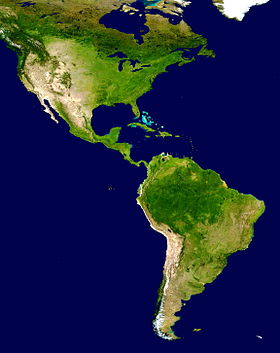
Back تاريخ الأمريكيتين Arabic Historia d'América AST Америка тарихы Bashkir Gschicht vo Amerika BAR আমেরিকার ইতিহাস Bengali/Bangla Història d'Amèrica Catalan مێژووی کیشوەری ئەمریکا CKB Dějiny Ameriky Czech Geschichte Amerikas German Historio de Ameriko Esperanto

The human history of the Americas is thought to begin with people migrating to these areas from Asia during the height of an ice age. These groups are generally believed to have been isolated from the people of the "Old World" until the coming of Europeans in the 1492 with the voyages of Christopher Columbus.
The ancestors of today's American Indigenous peoples were the Paleo-Indians; they were hunter-gatherers who migrated into North America. The most popular theory asserts that migrants came to the Americas via Beringia, the land mass now covered by the ocean waters of the Bering Strait. Small lithic stage peoples followed megafauna like bison, mammoth (now extinct), and caribou, thus gaining the modern nickname "big-game hunters." Groups of people may also have traveled into North America on shelf or sheet ice along the northern Pacific coast.
Sedentary societies developed primarily in two regions: Mesoamerica and the Andean civilizations. Mesoamerican cultures include Zapotec, Toltec, Olmec, Maya, Aztec, Mixtec, Totonac, Teotihuacan, Huastec people, Purépecha, Izapa and Mazatec.[1] Andean cultures include Inca, Caral-Supe, Wari, Tiwanaku, Chimor, Moche, Muisca, Chavin, Paracas, and Nazca.
After the voyages of Christopher Columbus in 1492, Spanish and later Portuguese, English, French and Dutch colonial expeditions arrived in the New World, conquering and settling the discovered lands, which led to a transformation of the cultural and physical landscape in the Americas. Spain colonized most of the Americas from present-day Southwestern United States, Florida and the Caribbean to the southern tip of South America. Portugal settled in what is mostly present-day Brazil while England established colonies on the Eastern coast of the United States, as well as the North Pacific coast and in most of Canada. France settled in Quebec and other parts of Eastern Canada and claimed an area in what is today the central United States. The Netherlands settled New Netherland (administrative centre New Amsterdam – now New York), some Caribbean islands and parts of Northern South America.
European colonization of the Americas led to the rise of new cultures, civilizations and eventually states, which resulted from the fusion of Native American, European, and African traditions, peoples and institutions. The transformation of American cultures through colonization is evident in architecture, religion, gastronomy, the arts and particularly languages, the most widespread being Spanish (376 million speakers), English (348 million) and Portuguese (201 million). The colonial period lasted approximately three centuries, from the early 16th to the early 19th centuries, when Brazil and the larger Hispanic American nations declared independence. The United States obtained independence from Great Britain much earlier, in 1776, while Canada formed a federal dominion in 1867 and received legal independence in 1931. Others remained attached to their European parent state until the end of the 19th century, such as Cuba and Puerto Rico which were linked to Spain until 1898. Smaller territories such as Guyana obtained independence in the mid-20th century, while certain Caribbean islands and French Guiana remain part of a European power to this day.
- ^ "Mesoamerican civilization | History, Olmec, & Maya | Britannica". www.britannica.com. Retrieved 2 July 2023.